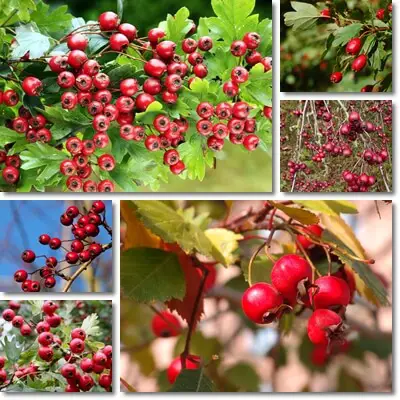There’s more to healthy fruit than just potassium-rich bananas, blueberries full of antioxidants or anti-inflammatory sour cherries with anti-rheumatic properties. Hawthorn berries are just one example. Hawthorn berry, but also leaf, flower, bud and twig extracts and various products made from hawthorn berries and other plant parts, such as hawthorn berry tea, have scientifically proven benefits for high blood pressure as well as benefits for congestive heart failure and exert a strong antioxidant action on cardiac cells and anti-atherosclerotic effects by regulating enzymatic activity and inhibiting the absorption of dietary cholesterol.
What are hawthorn berries?
Hawthorn berries are the fruits of the hawthorn plant, a species of shrub or small tree with edible berries, sprigs, leaves, flowers and buds and scientifically-proven medicinal properties. Hawthorn berries are called ‘haws’ and are only culinary berries. Botanically speaking, hawthorn berries are pomes like apples, crabapples, medlars, pears, quinces and even loquats (all belong to the same family, Rosaceae). There are several hundreds of different species of hawthorn, the best known being the common hawthorn, Crataegus monogyna.

What do hawthorn berries look like?
Ripe hawthorn berries look a lot like miniature crabapples and are tiny, oval-shaped, smooth-skinned, typically deep red in color, with whitish flesh and a single brown seed in the center in the case of the common hawthorn, Crataegus monogyna (also called oneseed or single-seeded hawthorn). Other species may have berries with multiple, smaller seeds in the center.
There are also species of hawthorn with red-brown, yellow, orange, blue, purple and black berries. For example, Crataegus brachyacantha has blue fruits when ripe, while Crataegus ambigua. C. pentagyna, C. saligna, C. douglasii and others have dark-red to purple-black fruits. Hawthorn species such as Crataegus pycnoloba, C. scabrifolia, C. dahurica. C. tanacetifolia and others have, at one point during the ripening process, yellow or orange berries.
What do hawthorn berries taste like?
Most, if not all species of hawthorn berries are perfectly edible both raw, fresh and dried, and cooked, although they may not taste good enough to be eaten raw. Ripe hawthorn berries taste tart, acidic. However you may choose to eat them, know that cooking can impact their nutrition and therapeutic effects, although processing such as drying or steeping in hot water for making tea does not appear to delete their most significant benefits for heart health, including for high blood pressure and heart failure.
How to eat hawthorn berries?
- Eat fresh, raw or dried. You can eat the haws whole, or just the pulp around the seeds (hawthorn seeds are generally not eaten). The dried berries may be finely ground and taken as dietary supplements or used to make tea.
- Sauces, jams, jellies or fermented beverages. You can cook haws to make sweet or tart sauces, hawthorn jam or jelly. Use any simple sauce, jam or jelly recipe, but remember that you will likely need to strain the seeds after cooking the fruits. Also remember that, unless sweetened, hawthorn berry sauce and other cooked haw preparations will naturally taste tart. Ferment the ripe and overripe haws with sugar to make a fermented beverage full of antioxidants.
- Other uses: dietary supplement. Wash and tap dry ripe haws using a paper towel, then leave to dry for (up to) several weeks. Remove the pulp from the seed/seeds, then grind into a fine powder using a kitchen food processor. Store the ground haws in a small jar or an old vitamin bottle, and keep in a dry, dark place.

Hawthorn berry tea
You can make a hawthorn berry tea by steeping dried or dried and ground haws into hot water for 5-15 minutes (you can use a reusable tea bag, cheese cloth or a tea ball for the fruit material). You can also make tea from fresh hawthorn berries by steeping the fresh and crushed haws into hot water for 5-15 minutes. It is also a common practice to boil the fresh haws for a 5 to 15 minutes on low heat to encourage the release of phytochemicals and other compounds with medicinal effects. If using whole, crushed haws for tea, you can also eat them afterwards.
Here’s a tip: You can improve the taste and smell of the tea by adding lemon or orange slices or juice, or sweetening with brown sugar or various types of raw honey, including hawthorn. Also see the benefits of hawthorn honey.
What are hawthorn berry pills and what are they used for?
Hawthorn berry pills are dietary supplements containing hawthorn berry extract or dried and ground hawthorn berries, typically the fruit pulp and skin, but without the seeds. The supplements boast a wide range of uses, the most prominent of which are scientifically-proven or enjoy evidence-based reports. Hawthorn berry supplements can be taken for high blood pressure, palpitations, extrasystoles or other forms of arrhythmia, congestive heart failure, chest pain (angina pectoris) and other cardiovascular problems, but also water retention, insomnia and anxiety. However, effects are dose dependent and likely to be affected by factors such as the species of hawthorn the berries are sourced from, berry ripeness, type and degree of processing and other factors which have a direct and sometimes meaningful impact on the nutritional and therapeutic properties of the berries and the preparations made from them.
What are hawthorn berries good for?
- Good for blood pressure. Hawthorn berry extract and tea benefits for blood pressure are a result of phytochemicals with antioxidant and anti-hypertensive properties such as anthocyanins, proanthocyanidins, procyanidins and other flavonoids, organic acids and antioxidants. Studies show procyanidins and other flavonoids and antioxidants in hawthorn induce relaxation in blood vessels and promote vasodilation, actively lowering blood pressure. Good amounts of potassium and diuretic components further contribute to the anti-hypertensive benefits of the berries.
- Benefits for congestive heart failure (chf). Hawthorn berries and preparations made from them have a strong cardiotonic effect that holds important benefits for congestive heart failure. Studies show biologically active compounds exhibit unique chronotropic properties, altering heart rate and rhythm, while a good potassium content and polyphenolic diuretic components help combat water retention and swelling, contributing to significant and quantifiable benefits for mild and moderate congestive heart failure.
- Benefits for angina. The symptom of angina pectoris, or chest pain, can be relieved by consumption of hawthorn berry pills or tea. The berries are a cardiotonic, strengthening the cardiac muscle, and dilate blood vessels for better blood circulation.
- Benefits for arrhythmia. Active constituents in hawthorn berries and preparations have been shown to alter heart rate and heart rhythm (both induce rhythmicity and exert anti-arrhythmic effects) contributing to benefits for palpitations, extrasystoles, tachycardia and other forms of arrhythmia.
- Cholesterol-lowering properties. Studies have shown hawthorn berries and preparations to reduce LDL (bad) cholesterol levels in the blood as well as triglyceride levels by regulating the activity of certain enzymes and inhibiting cholesterol absorption.
- Anti-atherosclerotic properties. The hypolipidemic effect and antioxidant activities of hawthorn that prevent lipid oxidation hold long-term benefits for atherosclerosis prevention, reducing the risk of plaque deposits in artery walls that could negatively impact cardiovascular health.
- Benefits for insomnia. Hawthorn berries have anti-arrhythmic and vasodilating effects that account for a drop in blood pressure that is conducive to relaxation and restful, uninterrupted sleep.
- Benefits for anxiety. The hypotensive and anti-arrhythmic effects of hawthorn could explain its anti-anxiety action. See other potent anti-anxiety herbs.
- Digestive benefits. The berries, especially the skin, are a source of pectin which helps regulate transit time and stool consistency, and contain active constituents with a vasorelaxant effect on smooth muscles, contributing to benefits for bowel regularity.
- Antioxidant benefits. Hawthorn berries are a source of antioxidants with varied biological activities (proanthocyanidins, flavonoids etc.), have free radical-scavenging properties, increase cell viability and exert a protective, anti-oxidative effect for vitamin E form alpha-tocopherol. The fruit skin and seeds are highest in antioxidants.
What are the side effects of Hawthorn Berries?
It is important to understand that hawthorn berry and other hawthorn plant part preparations have proven therapeutic effects and, as a result, require caution when using for various medical issues.
- Medicine interactions. One side effect hawthorn berry preparations can cause is interact with medication for high blood pressure, arrhythmia, heart failure (e.g. digoxin) and even insomnia or anxiety medication, especially if taken at the same time or close in time to one another. The concern is that hawthorn may potentiate the effects of some medication with potentially serious side effects. As a result, it is recommended to consult with your doctor first about the use of hawthorn and its preparations and discuss advantages vs disadvantages with regards to your conditions, best dosage for you and how to best use the herbal preparations to avoid side effects.
- Hawthorn and pregnancy. There are concerns that hawthorn may negatively impact fetal development which is why some professionals recommend against consumption of the tea or hawthorn berry pills during pregnancy.
- Potential for allergic reactions. Although rare, it is possible to be allergic to hawthorn berries, but also flowers and preparations made from them. In case of an allergy, avoid the allergen in all forms and preparations.
- Other side effects. Healthy individuals as well as individuals with cardiac problems such as heart failure may experience nausea, lightheadedness, dizziness, arrhythmia and other minor to mild cardiac and digestive side effects when consuming hawthorn berries and preparations. The side effects are dose-dependent.
